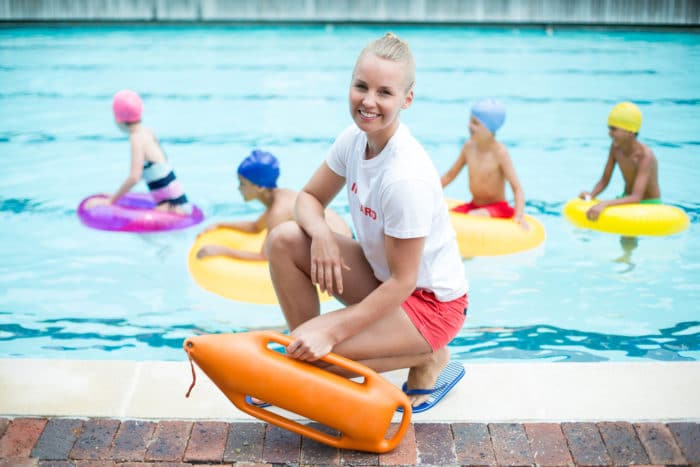Why We Love It
-
$21,930Potential Avg. Salary
-
6.7%Job Growth Rate
-
Growing DemandJob Outlook
-
Don't Take Work HomeCareer Attribute
Lifeguards are the individuals responsible for the safety of people in and around bodies of water. They may watch over a variety of water types, including indoor and outdoor pools, ponds, lakes, rivers, and oceans—anywhere where people are swimming. They offer emergency care and prevent drowning.
Recommended Schools
What is a Lifeguard?
The following job responsibilities are common for individuals in lifeguard roles:
- Oversee actions of individuals in and around bodies of water
- Observe for signs of trouble, which could include drowning or even simple rule-breaking
- Rescue individuals who are drowning or in other dangerous situations
- Perform CPR, first aid, and other emergency resuscitation procedures
- Notify swimmers and visitors of dangerous situations, and get everyone out of the water when required
A Day in the Life
Lifeguards help keep people safe while swimming in or enjoying recreational activities around bodies of water. Generally, they work in watchtowers or other elevated areas that provide full views of the protected area. From these elevations, lifeguards can monitor people in and around pools to look for signs of distress or danger. Most often, lifeguards are there to prevent and rescue people from drowning, but their responsibilities are much more varied than simple drowning prevention.
Lifeguards are also responsible for enforcing rules in the areas they monitor. Depending on the body of water they’re managing—which could be a pool, pond, lake, river, or ocean—they must make sure people are not doing things that elevate the risk of injury. At pools, lifeguards may keep people from running and slipping. At oceans, they may keep people from entering areas with swift currents or motorized vehicles. They make sure everyone follows the rules so that the day is safe and risk-free.
When an incident or injury does occur, the lifeguard acts as a first responder much like a paramedic would. He/she removes drowning individuals from water, performs CPR to remove water from lungs, and treats cuts, burns, and other minor injuries. For this reason, it’s crucial for lifeguards to be trained both in swimming and first aid because they often care for injured people before emergency responders arrive. The actions a lifeguard takes can help save people’s lives.
Typical Work Schedule
There is no typical working schedule for lifeguards because the schedule they work depends a lot on the employer. Lifeguards who work at indoor pools may work fulltime year-round, and may work first shift, second shift, and weekends. Those that work in outdoor pools, oceans, and other bodies of water may work seasonally—depending on location—when the weather is warm enough for swimming.
Typical Employers
Lifeguards can be employed by a variety of businesses. Some work at indoor pools for businesses like the YMCA; some work for amusement or water parks like Disney Land, Disney World, or Six Flags; some work for hotels that have on-site pools; and some work for government and oversee pools, lakes, oceans, rivers, quarries, and ponds on government land where swimming is permitted.
Recommended Schools
How To Become a Lifeguard
To work as a lifeguard, you must be certified, but before becoming certified, you must already be an exceptional swimmer. Before pursuing certification, it’s good to take some swimming classes or at least practice swimming on your own time. The certification course provides advanced training in CPR, first aid, automated external defibrillator (AED) usage, and general pool management—but not in general swimming. The expectation is that you are already a qualified swimmer before you begin training.
Earning a lifeguard certification can be achieved in a number of ways. The most popular is through the American Red Cross which offers a lifeguard training program recognized by all potential employers. However, you may also be able to become certified by organizations like the YMCA or even through a private employer certification program. To begin training, you usually must be at least 15 years old, and the training may require up to 40 hours of instruction. You must also be recertified every two years.
To pass the training course and earn your certification, you usually must be able to tread water for two minutes, to swim between 200 and 400 yards, and to retrieve a 10-pound brick from the bottom of an 8-10 feet deep pool after diving in feet-first. When practicing swimming before signing up for the training course, it’s good to review the requirements you’ll need to complete successfully to pass the course so you can practice those tasks as you prepare for lifeguard training.
Lifeguard Salary Data
We’ve provided you the following to learn more about this career. The salary and growth data on this page comes from recently published Bureau of Labor Statistics data while the recommendations and editorial content are based on our research.
National Anual Salary
Low Range
$17,980Average
$21,930High Range
$30,790National Hourly Wage
Low Range
$9/hrAverage
$11/hrHigh Range
$15/hrHow do Lifeguard salaries stack up to other jobs across the country? Based on the latest jobs data nationwide, Lifeguard's can make an average annual salary of $21,930, or $11 per hour. This makes it an Above Average Salary. On the lower end, they can make $17,980 or $9 per hour, perhaps when just starting out or based on the state you live in.
Salary Rankings And Facts
#801 Nationally for All Careers
Highest Education Among Lifeguards
- 1.2% Doctorate
- 4.1% Masters
- 21.8% Bachelors
- 10% Associates
- 26.4% College
- 30.3% High School
- 6.3% Less than High School
Job Growth Projections and Forecast
2014 Total Jobs
141,3002024 Est. Jobs
150,800Job Growth Rate
6.7%Est. New Jobs
9,500How does Lifeguard job growth stack up to other jobs across the country? By 2024, there will be a change of 9,500 jobs for a total of 150,800 people employed in the career nationwide. This is a 6.7% change in growth over the next ten years, giving the career a growth rate nationwide of Below Average.
Growth Rankings And Facts
#334 Nationally for All Careers
What Companies Employ The Most Lifeguards
| Industry | Current Jobs | New Jobs Needed | % Increase |
|---|---|---|---|
| Local government, excluding education and hospitals | 48,900 | 2,800 | 3% |
| Fitness and recreational sports centers | 31,400 | 2,700 | 3% |
| Civic and social organizations | 19,900 | 200 | 0% |












